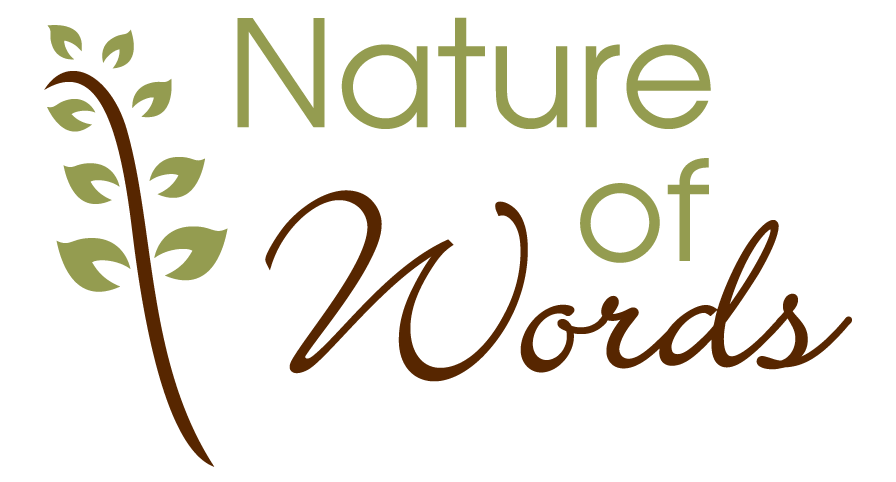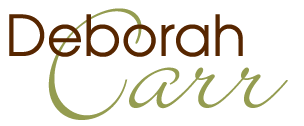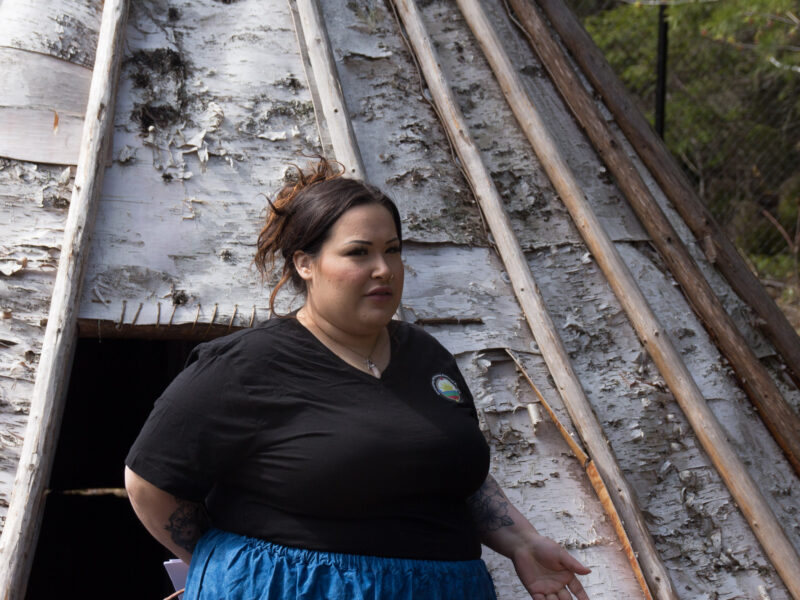
The Long Walk
(Saltscapes Magazine June/July 2024)
Elsipogtog travels a Healing Path, moving past colonialism’s painful legacy
Under a smudged, overcast sky, Shania Dedam is lighthearted as she stands with guests beside a towering white pine, explaining traditional Indigenous uses and knowledge associated with the species. She holds up a small clump of old man’s beard.
“When this lichen is green,” she says, “it means the air is fresh, so it can be used medicinally. But it’s toxic in high doses, so don’t be using it at home or you won’t be ‘lichen’ it!”
Her pitch-perfect delivery garners appreciative chuckles from the group.
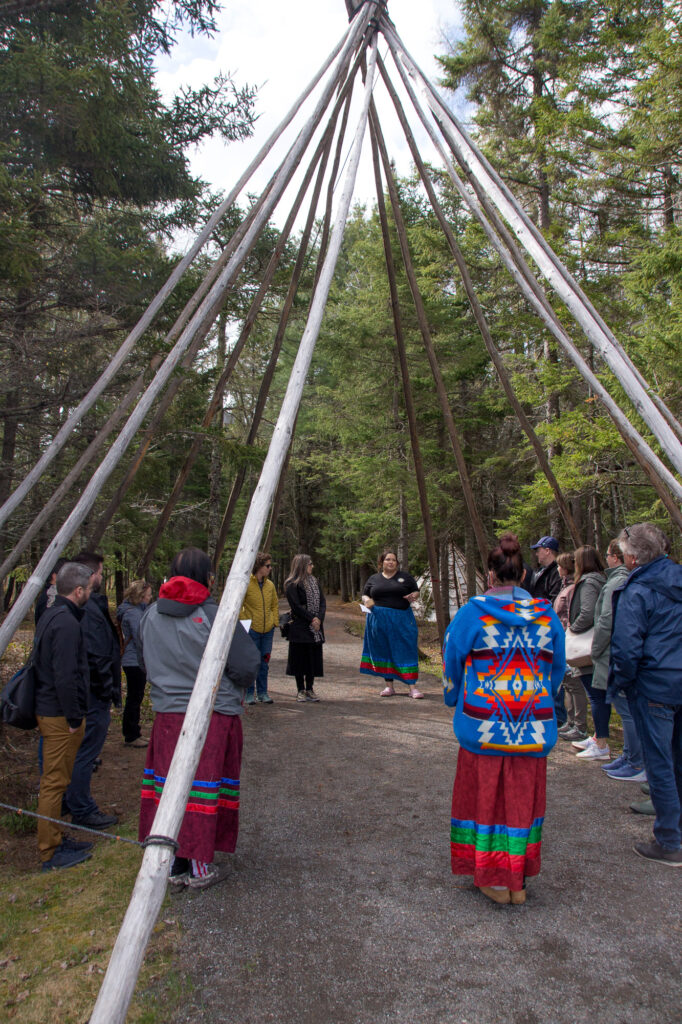
Tour participants gather at the start of the Heritage Path (copyright Deborah Carr)
It’s the first tour of the season for Dedam and her fellow interpreters, Kayla Peters, and Katelynn Simon who welcome visitors to the Mi’kmaq Cultural Centre, Artisan Shop and Heritage Path in Elsipogtog. All three grew up on the First Nations reserve on the banks of the Richibucto River, whose name is thought to be a distortion of the Mi’kmaw word ‘Lichibouktouck’ (or Elsipogtog), meaning “River of Fire.”
Elsipogtog is New Brunswick’s largest First Nations community. Formerly known as Big Cove, it reclaimed its Mi’kmaw name in 2004, a significant step towards healing a painful colonial past.
During an introductory session before the walking tour started, Peters explained ceremonial customs and displayed various items of Mi’kmaw regalia. Then the young women conducted a smudging ceremony, during which tobacco, sage, cedar and sweetgrass were burned to cleanse the body and mind of negativity, and open it to compassion and understanding, before leading us outside to the Heritage Path.
Now, as we pause by various trees and plants, a birch-bark wigwam, longhouse, and sweat lodge, they share some of what traditional community life may have been like generations before. A longhouse, for example, housed multiple families. Skins or clothing hung from the ceiling for privacy and to insulate in winter, and a firekeeper maintained the fire. As well, people gathered within to share stories and teachings, or hold important meetings and discussions.
Although the Heritage Path itself isn’t long, the journey to reach this place had been an arduous one of loss, separation, and pain. While walking, one gains a sense of the strength, wisdom, and ingenuity of the ancestors who lived in harmony with the land for thousands of years before European settlement, and how their descendants are reviving their long-silenced voices, influence, and knowledge.
Tragic legacies
Two years ago, Dedam had finished esthetician training and was looking for a summer job while starting her own business. A friend working at the Mi’kmaq Cultural Centre told her it needed guides for their Heritage Path Tour.
“I had no idea what it was,” she recalls. “My parents were Catholic, so I knew everything about Catholicism, I was even an altar girl, but I knew nothing about my own culture.”
This was just one of the tragic legacies of the residential school system devised to assimilate Indigenous children into Canadian society by prohibiting their cultures and languages. The government’s collaboration with churches to forcibly remove First Nations children from their families had driven an axe into family life. The ones left behind lost their purpose of passing on knowledge and tradition; the young ones lost their cultural roots and family love. Abuse was rampant and thousands of children perished at these schools. In 2015, the Truth and Reconciliation Commission described it as cultural genocide.
Dedam’s maternal grandmother was a survivor of the Shubenacadie Residential School in Nova Scotia. The school, which operated from 1929 to 1967, was the only official residential school in the Maritimes. “What my grandmother told me was insane, horrible, yet some people still say it didn’t happen.”
Grounded as she was in Catholicism, Dedam’s only exposure to Mi’kmaw culture had come from an Indigenous youth retreat where, at 16, she experienced ceremonies for the first time. Now 24, she’s finally learning from elders in her own community, placing the fragments she knew into context, and realizing a piece of herself had been missing.
“It felt like second nature hearing it. Like it was in my heart all along,” she says. “I never thought I could speak in front of groups of people, but I was able to pick it up quickly along with the other girls. Now working here is like another family. It’s not just the work. We support each other and that makes the work so much bigger.”
Building relationships
Lynn Francis is director of Elsipogtog Economic Development, the organization behind the Mi’kmaq Cultural Centre and that shares its space with the centre. She’s had the job for 26 years. In that time, she’s seen and encouraged many positive changes.
“We work with leadership in the community, asking what they want and how to make those things happen. And we serve community members who want to start their own businesses,” she says. Many of these activities focus on the forestry and fishery sectors, which utilize traditional knowledge and skills.
Francis’s impetus for tourism came 20 years ago when she scanned a provincial visitor guide, wondering what it said about her community. “I found two sentences: ‘Drive to Big Cove, turn left. See the totem pole.’ That was it.”
Nothing about the culture, ceremonies, community celebrations, pow-wows, medicines, skills, or the knowledgeable elders who carried the teachings. “I thought, we have a way of life here that’s rich in culture and history. It needs to be shared,” she says.
In 2015, she and her team began developing a tourism strategy, and the ideas for a cultural centre, tour and gift shop slowly took shape. Community elders shared their memories and knowledge to aid decision-making, and the centre began to offer workshops on beading, basket-weaving and drum-making.
“It was an honour for elders to come in and share their insights. I could sense pride from them, and from the interpreters too. In this way, we’re building stronger ties between the generations,” says Francis.
“Now many people want to come and experience this. To have our doors open to the world is a major accomplishment.”
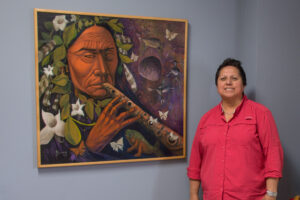
Director Lynn Francis alongside an original paining. “Gisolg” (meaning “the one who made you”) by late Mi’kmaw artist, Roger Simon. His art is prominently displayed throughout the centre. (copyright Deborah Carr)
As was bringing home a national tourism award.
“We’re a humble people,” Francis adds. “It’s not about winning, but about being recognized nationally. And knowing we’re building relationships between the elders and the youth, and the community members who have been inspired to bring their creations for us to sell. Now elders come in on a regular basis, just to see what’s going on or to share what they know, and we sit around that elder and listen.”
She’s unsure what the future holds. “I just hope the community continues to build and grow. And embrace our elders, not only to listen with our ears, but with our hearts and our light within, to make the changes we need to make to build a positive future for our youth and those who are not here yet.”
“Laughter is healing”
I see Francis’s hope play out after the walking tour, when visitors are offered bannock and tea, and a safe space to ask questions.
“Ask me anything,” Dedam says. “I’m an open book.”
Reconciliation between cultures will only succeed if we fill the gaping hole that exists in Canada’s history. Essential to this is creating a place for honest communication and connection. Where stories can be shared. And heard.
A discussion on the smudging ceremony leads to memories of mothers and grandmothers opening the doors and windows to shoo bad energy and negativity from the house, which then leads to stories about caring for elders during COVID.
The mood shifts when one of the visitors presents each interpreter with a small, red pouch of tobacco — a gift traditionally given to elders who share teachings, or to Mother Earth when taking resources.
“My daughters helped make them,” he says.
Katelynn Simon clutches hers, visibly moved. “This is the first time anyone has ever given me tobacco.”
Someone asks about the significance of the red cloth. “Red is sacred,” she says. “You store your eagle feathers in red cloth.”
Then Kayla Peters tells us about an eagle feather given to her at birth. “It hung on my crib when I was little, but I lost it in my teenage years.” By that time, she said, the individual barbs along the shaft had become tattered and separated, which the elders said represented the obstacles she’d encountered in her life. But the tip of the feather remained strong and true. She would find her way through, they said.
Her eyes filled as she spoke of losing her sister. Tiffany Ann Marie died by suicide in 2018 after being unable to find help to escape human traffickers who were threatening her and her family. “She’s the only sister I had and they took her from me.” Peters shares her story hoping to illustrate the dangers faced by murdered and missing Indigenous women and girls.
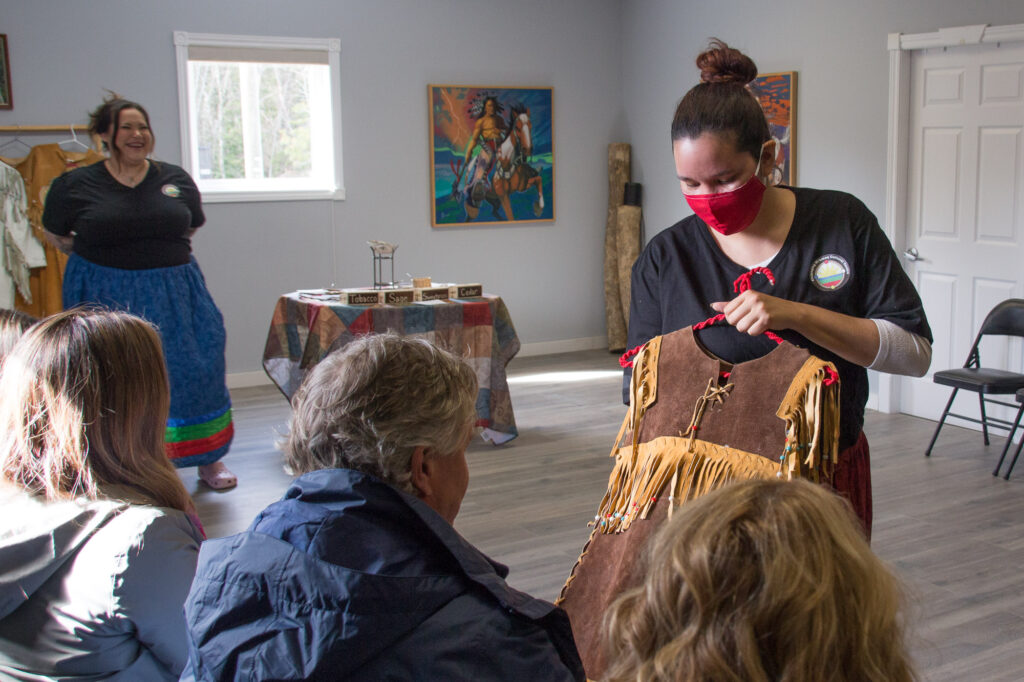
Interpreter Kayla Peters shows traditional buckskin regalia made of horse and deer hide. Sometimes women dream of special regalia to be made for an individual, then design and construct the garment as dreamed. (copyright Deborah Carr)
“Growing up on reserve, all of us have some form of trauma. My mother didn’t know how to talk about it. I’m tired of being depressed and not knowing why. It’s up to us to stop the cycle. I’m proud of how far we’ve come. I never had my language, but my children are now learning M’ikmaw songs in our school.”
A small smile breaks through. “Laughter is healing,” Peters says. “Native people know this.
Later, Dedam reflects how she’d never really understood the depth of struggle her people faced until she took this job.
“This is so much bigger than I thought. For so long, people could not talk about their pain. But now we’re receiving resources in the community, and our culture is being brought back. The things we talk about in the Q&A open my eyes as to what I can be doing in community, and with the youth here. My expectations for myself have changed. I’m now going for a bachelor of arts with a major in social work to help my people.”
She hopes more people will take the initiative to learn about Indigenous culture. She recalls her best work day ever as one in which guests and guides connected with unexpected honesty: “We all felt so safe, and we shared intimate stories. I’ll never forget any of those faces. We gained so much from our guests. It didn’t matter that our cultures were different, we’re cut from the same cloth and can connect on so many levels.”
(Cover image: Heritage Path interpreter Shania Dedam explains the purpose of a traditional birch bark longhouse. Copyright Deborah Carr)
